Family : Pandionidae

Text © Dr. Gianfranco Colombo

English translation by Mario Beltramini
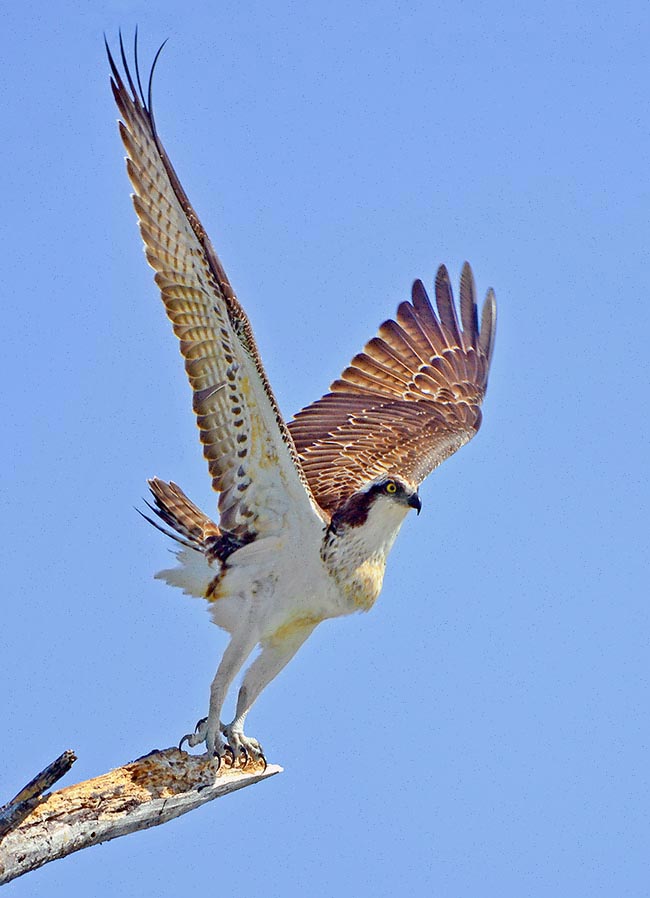
Ubiquitous and very visible where present, Pandion haliaetus is vastly diffused in the world with 5 subspecies © Gianfranco Colombo
Though being a bird present in all continents and well diffused in any suitable range, the Osprey is always a prey coveted by all birdwatchers and ornithologists of the whole world, because its number is never high and any sighting is always an extraordinary experience.
This ubiquitous and very visible bird, where present, is for many a real chimera and rarely observed during their life. It does not hide in dense and impenetrable woods, does not skulk in deep and unreachable ravines but, on the contrary, loves to perch on withered and bare trees, on road pylons and where more common, also on port equipment and on coastal buildings. Also the nest follows these canons and is always and invariably visible from far away although reachable only from above.
In some locations this bird has also become an emblem of a longed-for return after years of absence and only through assiduous and constant protections has succeeded in positioning definitely and now to be considered as stable. The most known example of this success is the Loch Garten in Scotland where in 1950 a couple of these birds began to nest after an absence of more than 50 years.
The disappearance was caused by the unlawful cullings of the few present specimens and the continuous thefts of eggs, done by unscrupulous collectors, done with such insistence to materially oblige the couples present to abandon this secluded and unusual corner of their range.
This was a very important event for the passionate English observers and there was a very consistent flow of visitors, so much that the whole area was peacefully invaded by nature lovers who with the due care and prevention, indirectly guaranteed also a vast protection to this new arrival.
Also in the following years the nidification was frequent and even more constant was the presence of controls so the nest would not suffer from any danger and risk of failure. The very few couples present had now stabilized but they were still too reduced in number to sing victory.
They say it occurred during a dark night of early May 1958, when a thief of eggs, on a small boat, reached stealthily the withered tree at the centre of the small lake near Loch Garten, Scotland, where was located the nest of this extremely rare bird and climbed up, stole its contents.
It was then established a system of control of these nidifications, increased in the years, with the positioning of electronic systems that have ensured the safety over time. However, nature is strong and resistant and in the following year began again those nidifications that, consolidated, are still there.
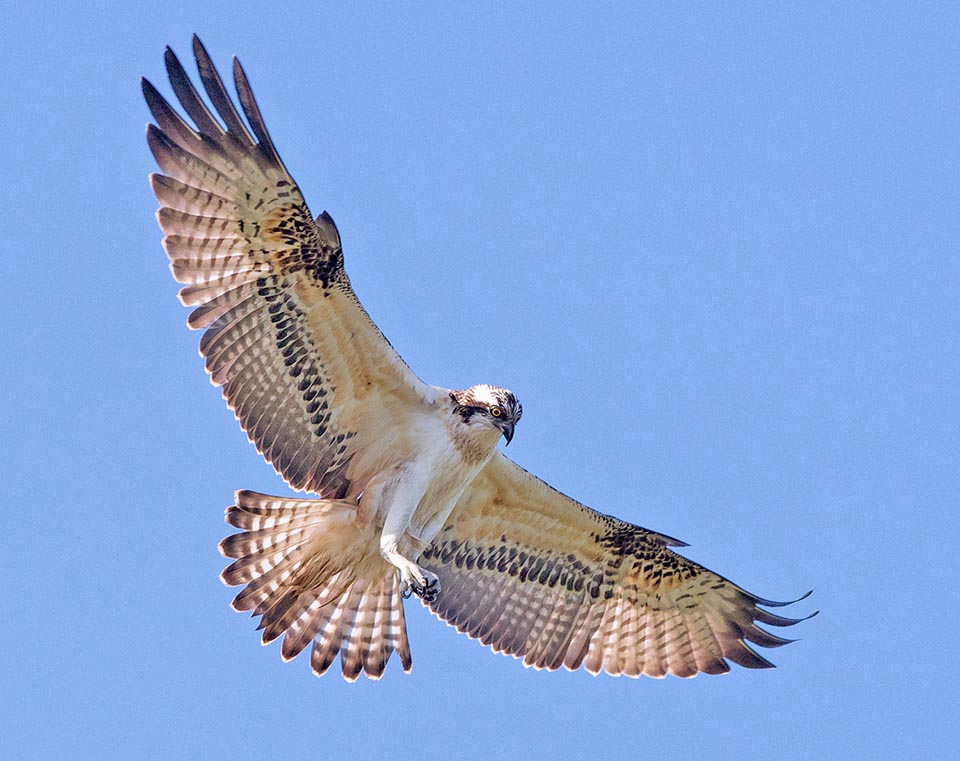
It eats only marine or freshwater fish, observing from the air, at times motionless, the water surface. Once seen the prey it rapidly dives © Gianfranco Colombo
To say Osprey, the English name of this bird, is now synonymous with protection, of beauty and of rarity, and, in England, the memory of this adventurous story is still remembered by all.
The Fish hawk, or Osprey (Pandion haliaetus (Linnaeus, 1758)) is a raptor belonging to the order of the Accipitriformes, to the family of the Pandionidae, a unique grouping created for allocating this very particular species.
It is in certain aspects a sea eagle, so much so that the name given to the species reflects this characteristic: haliaetus from the Greek “hali”= sea and “aetos” = eagle, even if, actually, it had nothing to do with the real sea eagles, mighty and massive birds that lack the elegance typical to this anomalous hawk.
In fact, for the sea eagles of all the world, the epithet haliaetus, declined in haliaeetus, has been given to the genus instead of the species. In Africa, the African fish eagle (Haliaeetus vocifer), in the Asian Far East, the Steller’s sea eagle (Haliaeetus pelagicus), in Europe, the White-tailed sea eagle (Haliaeetus albicilla), in America, the Bald eagle (Haliaeetus leucocephalus), in Oceania, the White-bellied sea eagle (Haliaeetus leucogaster).
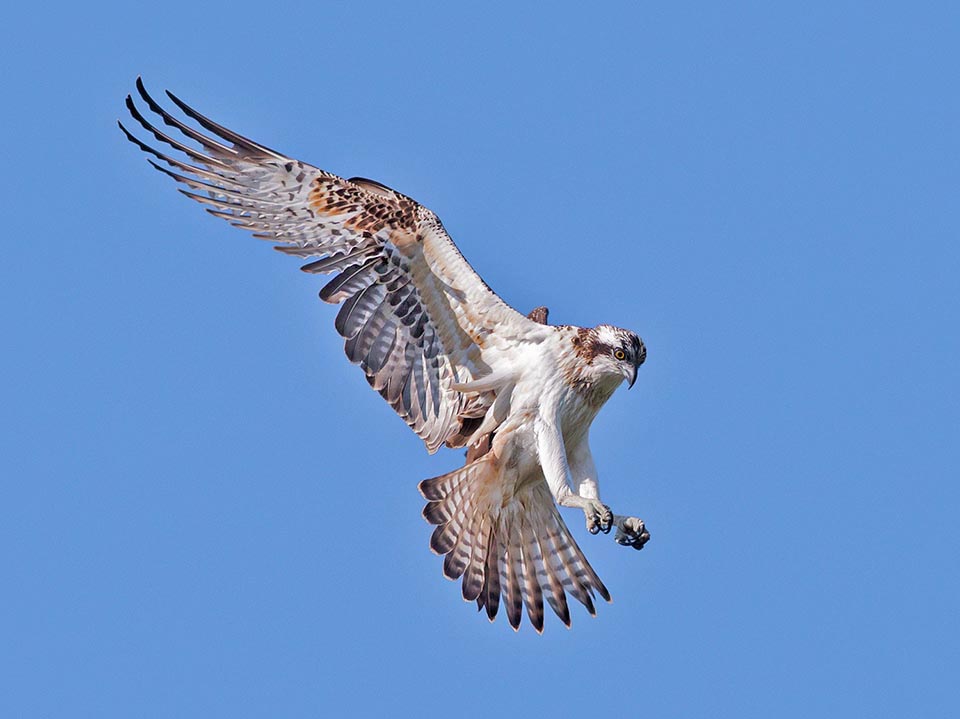
It has not yet been understood how it can be able to grasp it precisely at several tens of centimetres of depth, not at all confused by the refraction done by the water. Usually is a pike, salmon and trout when fishing in northern cool areas and sea bass or mullet when diving into the waves of the sea © Gianfranco Colombo
Also in the behaviours, it shows very strong differences. Very long legs and claws resulting among the most marked and, as we shall see, very specialized. Finally, hunting and the preys. The Osprey loves only and almost exclusively fish, live and darting fish, preferably of big size that catches not on the surface with a simple and low and glancing fly, but by diving and immersing totally. Concluding, this bird is actually different from all its similars even if at the same time it looks the same to everyone.
The etymology of Pandion has a mythological origin of old Greece, very confused and differently interpreted.
Pandion II is the name of a legendary king whose son Nisos was transformed in a raptor, after some in a Sparrowhawk (Accipiter nisus), after that his city was given to the enemy, with the treason, by his daughter, Scylla, in turn transformed into a lark forever doomed to escape from her hawk father. Others affirm that instead of a Sparrowhawk, he had been changed into a Fish hawk (Pandion haliaetus) and the daughter into a fish, thus perpetuating the concept of eternal persecution.
In the European areas where it is common, it is called: in German, Fishadler, in Spanish, Águila pescadora, in Finnish, Sääksi, in French Balbuzard pêcheur, in Norwegian, Fiskeørn, in Russian Скопа, in English Osprey and in Italian Falco pescatore. A universal name: evident is the repetition in the name of the matching eagle-fish.
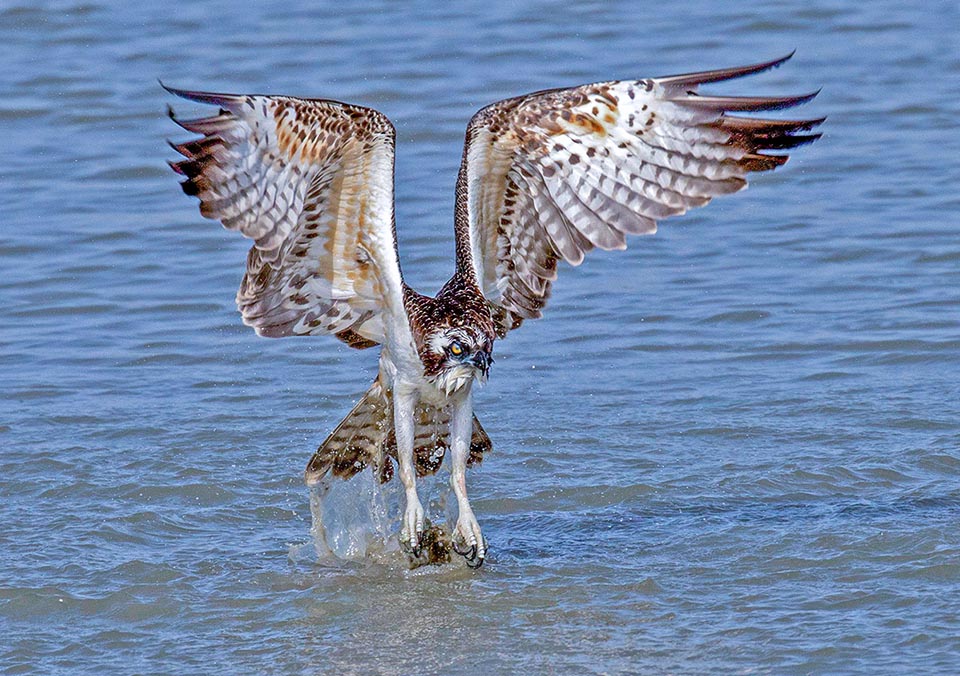
Almost always emerged with a 100/200 g fish, well held between its sharp claws, the right quantity of daily meat that it needs © Glauco Vicario
Zoogeography
In 1956 with the cutting of a withered tree in the Alimini swamp (between Lecce and Otranto) where was located a nest of this already rare bird, happened the last nidification on the Italian mainland of the Osprey.
In the Mediterranean area continued some rare and scattered nidifications in Sicily and in Sardinia but they too were designed to disappear. In the Mediterranean remained only some couples nesting in Tunisia, Morocco, in the south of the Iberian Peninsula and in Corsica. Very diffused it remained on the coasts of the Red Sea and in the Arabian Peninsula whilst on the European continent, the western part is since centuries totally uncovered, apart Scotland, as mentioned before.
In the last decades it has been noted a moderate return in some Mediterranean areas previously inhabited or the strengthening in the number of the populations already existing favoured by the creation of protected areas and with the installation of platforms suitable for the nidification, even if the situation has not consolidated at all. Conversely, it lives diffusely in the Scandinavian Peninsula and in European Russia from the tundra to coasts of the Black Sea and eastwards goes into Asia up to the Pacific Ocean coasts, Kamchatka included.
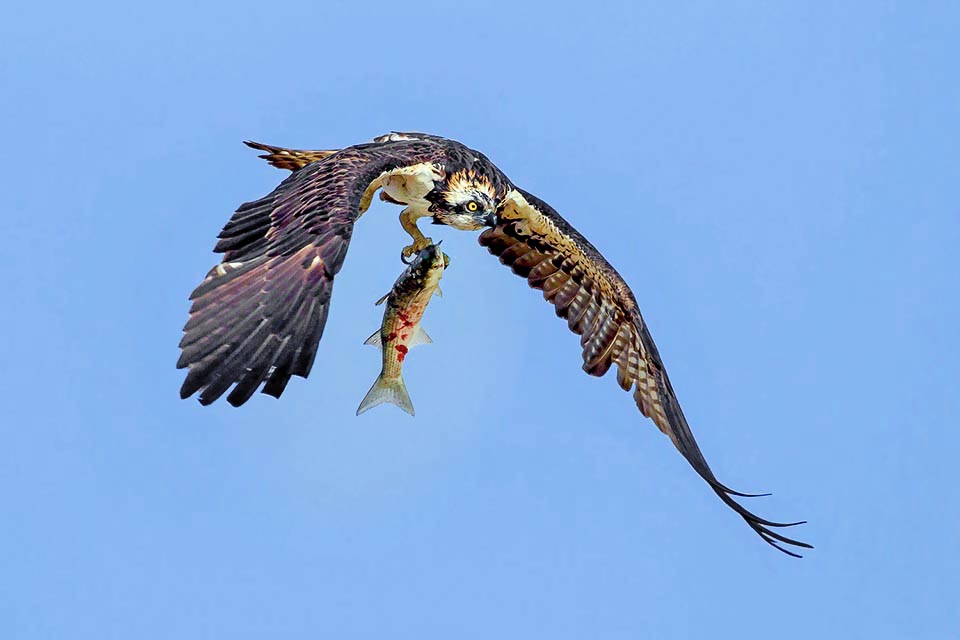
Here it is with a just fished mullet. Pandion haliaetus can have a 180 cm wingspan, with 65 cm of length and a weight of about 1,5 kg. © Glauco Vicario
It is widely diffused also in North America maintaining the same latitudes occupied in Eurasia to reach, southwards, the Caribbean coasts where it is present in a good number.
In Asia it also occupies the extreme south-east, south of the Equator, reaching most of Oceania, proving to adapt easily to any climate and environment.
The Osprey is a long-range migrant in those areas where the winter has unbearable climate characteristics but, on the contrary, is sedentary in the tropical ones and in those of Oceania.
The European and western Asian populations migrate in Africa in the sub-Saharan and austral belt up to South Africa, with now presently report of cases of wintering of some individuals also in the Mediterranean area. The North American ones winter from Mexico until touching Argentina and Chile whilst the central-Asian and Siberian ones spend the winter in the Indian peninsula, in the Indo-Chinese and in Indonesia. The Indo-Australian ones are mostly sedentary apart from some populations that go to winter northwards, in Indonesia.
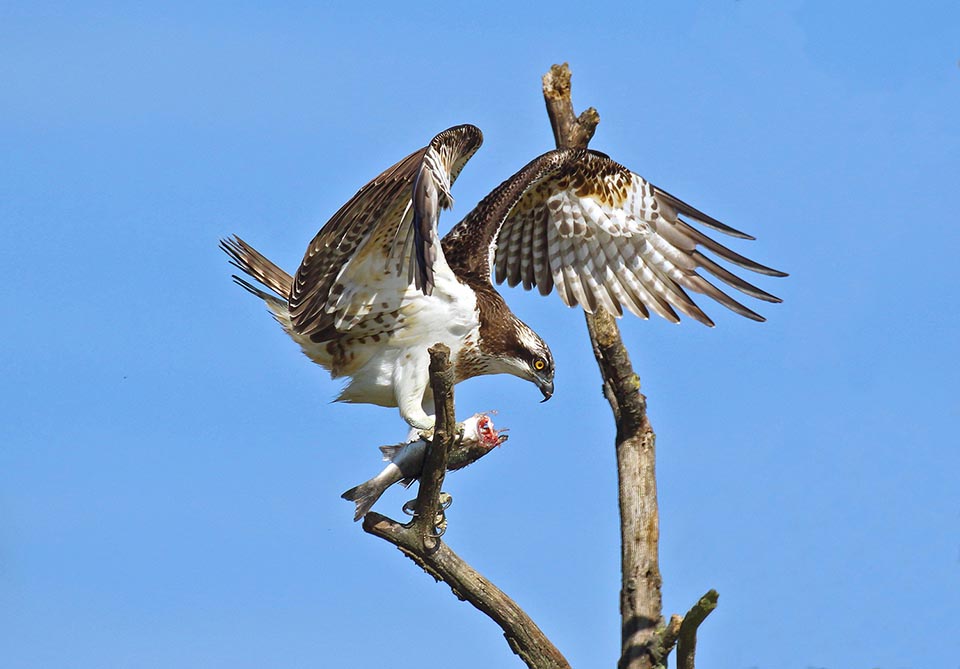
Here it is in the usual dining room, place with no intruders, where it can calmly devour it © Glauco Vicario
The migration of this hawk occurs in a solitary way and through not well determined routes, therefore it may happen accidentally even in never frequented areas not corresponding fully to its ideal habitat.
It erratically crosses deserts and seas, densely populated areas of high mountain ranges stopping from time to time when it finds surfaces of water where to go for fishing.
It is not known exactly how long its transfer towards the winter quarters lasts but it is thought that lasts in several months and that it is conditioned by the environmental temperatures.
May be, it is for this reason that always more often we see local wintering in the Mediterranean area particularly during not too harsh winters. The wintering occurs in coastal sites or, if inland of the continent, close to large lake areas that suggest them their natural habitats.
Four subspecies, specific for each continent, have been classified.
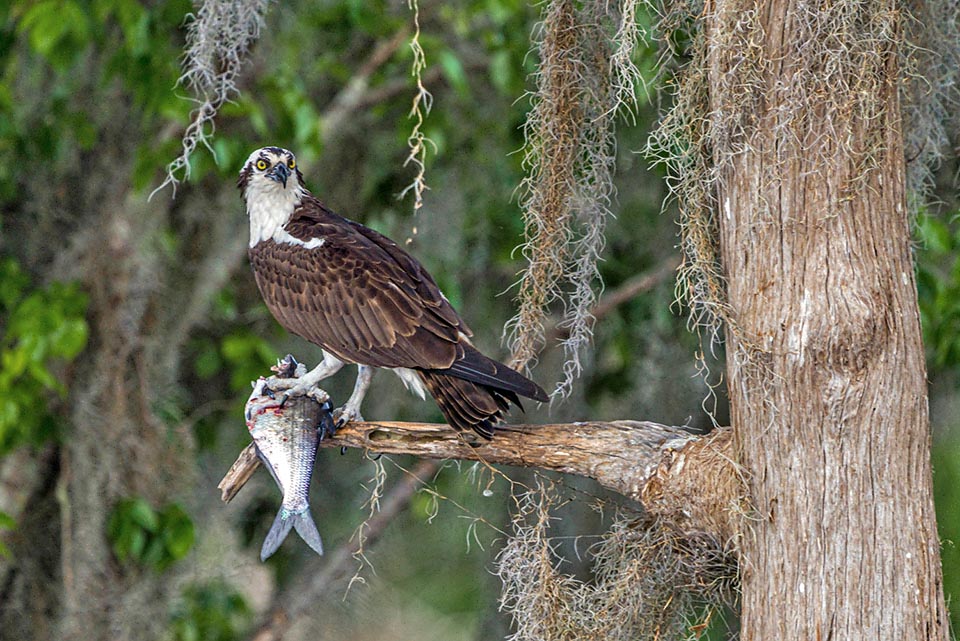
This, in America, prefers the nearby forest, with trees adorned with the falling festoons of Tillandsia usneoides © Gordon Magee
Pandion haliaetus haliaetus for the populations of Europe and Asia, Pandion haliaetus carolinensis for North America, Pandion haliaetus ridgway for Central America and Pandion haliaetus cristatus of Australia and Oceania, even if the latter is by many considered as risen to species level with the name of Pandion cristatus.
Ecology-Habitat
The Osprey is a bird indissolubly linked to water. The site of nesting is always placed close to this element and only in very rare instances, at a very short flight distance from water surfaces, as this is the environment from which it gets its food.
The marine coasts are the main habitat for the populations living in tropical areas such as in Australia and generally in Oceania, in the Gulf of Mexico in America and on the Red Sea and Arabian peninsula in Asia.
The lakes and the large estuaries are on the contrary the places where it is mostly found in the boreal areas.
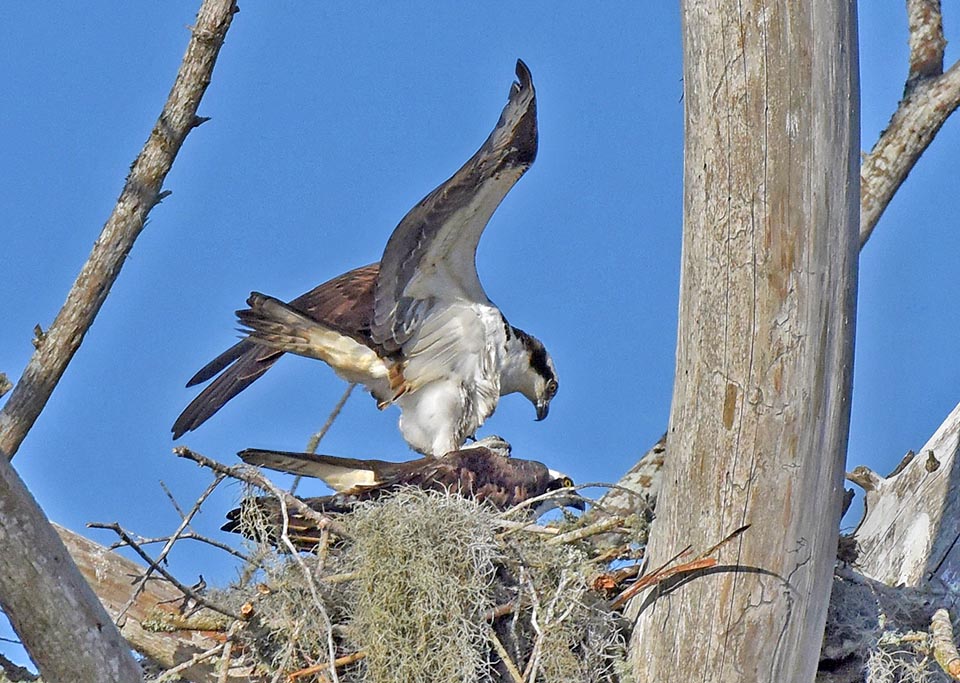
Weddings in Sweetwater Wetlands Park, a Gainesville in Florida. The couples are seasonally monogamous and dissolve with the first cold, when the migration time has come © Erika H. Simons
Finland, where is found the greatest European concentration, with its 180.000 lakes and 188.000 islets, represents more than any other nation, the ideal habitat for this bird.
Coastal woods with big withered trees, overlooking the water surfaces, are places particular suitable to their exigencies: from this position, elevated and free form visual obstructions, can directly eye the food in the underlying water and hunt it, keeping a close eye in the meantime on their nest and their progeny.
Morphophysiology
As already said, the Osprey is very visible where it is present.
Bare trees where to perch, structures in open air where to put the nest and its wandering on the water when necessary, renders its presence easy to be found. Moreover, it is a bird of a remarkable size that cannot go unnoticed when flying.
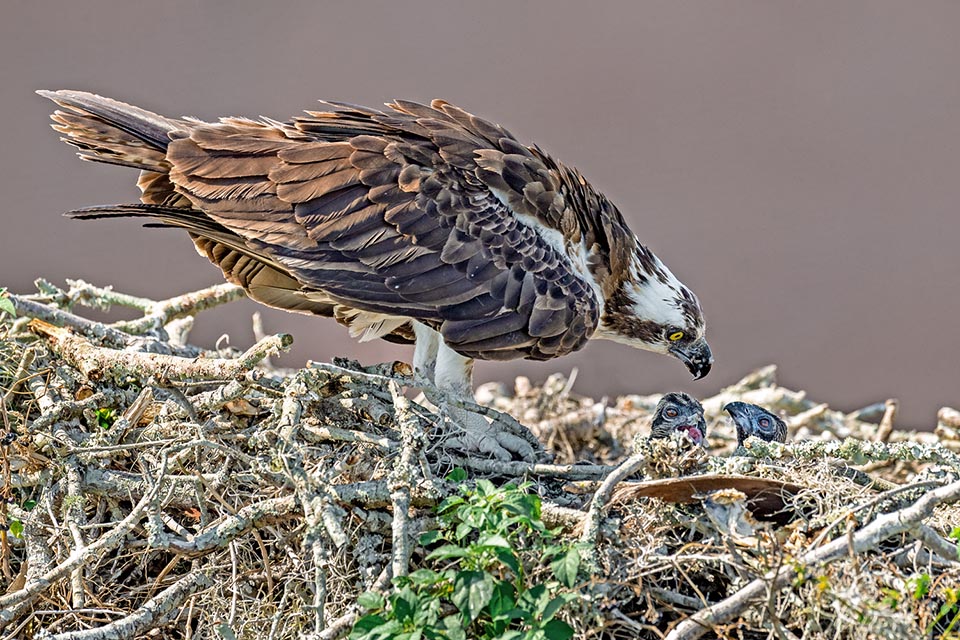
Two hungry chicks in the nest: a platform made with big branches at the base, covered inside by moss, barks and straws to form an ample and comfortable cup © Randy G. Lubischer – NJ, USA
It has a wingspan reaching 180 cm, with a length of 65 cm and a weight of about 1,5 kg, therefore it is a bird having the same size as a real eagle.
The flight of an Osprey is practically the same as that of a big seagull: deep and rather slow wing beats and direct flight till when, seen something interesting on the ground, here it is, to brake and elegantly rotate on itself to perform the hovering and, if satisfied, ending with a wings parted swoop with the legs well leaned forward until hitting the water and immerse even totally under the surface, emerging, without fail, with a big fish.
It has not yet been understood how it is able to catch the prey so accurately several tens of centimetres deep, albeit confused by the water refraction. It is sure that almost without fail it reappears on the surface with well hooked with its acuminate claws, a big fish.
The colouration of this hawk is practically in white black, if it weren’t for the eye with yellow iris, lemmon in the adults and orange in the young, that is the only mark of colour of its livery.
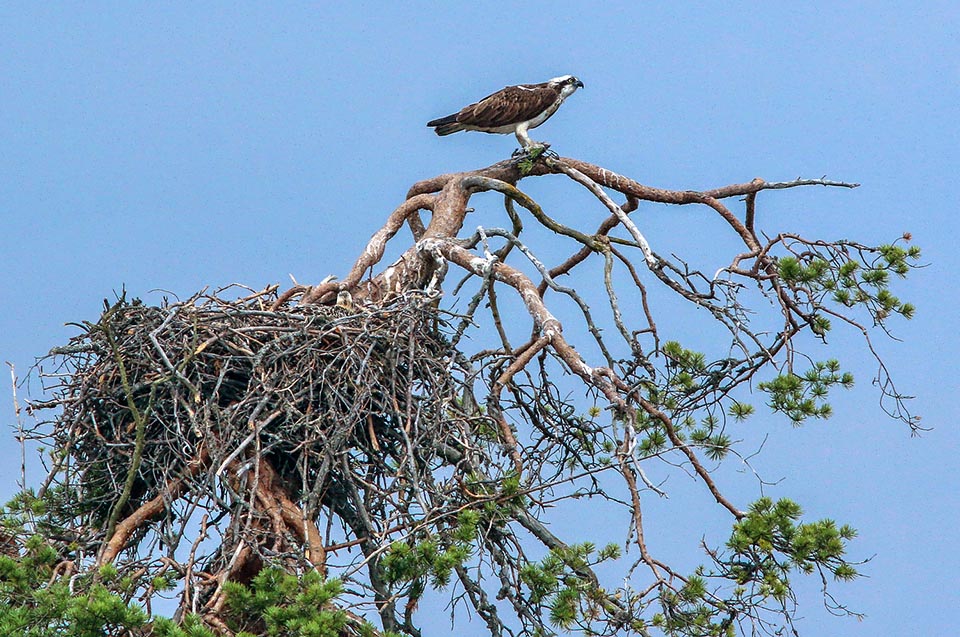
Always unreachable if not from above, the nest is often placed in big withered trees, overlooking water surfaces, to have the eye on the food and the chicks in the meantime © Veijo Ilomäki
A blackish wing cover, a body totally candid and a marked barring of the remiges, primary as well as secondary, when observed from below.
The tail is also barred in the lower face and during the pull-up done while fishing, almost always opened out like a fan. The head too is whitish and has a long ocular bar, more or less marked depending on the age, that, starting from the junction of the beak, connects on the nape like a light collar.
On the head it has feathers slightly erectile so much to allow a glimpse to a hint of a blackish crest and rightly this characteristic has been determinant for classifying the new Australian species.
Also on the chest appears a more or less marked brownish black ot black halo forming a bib often well visible even from far away. The black bill is very hooked and big. The legs are quite long and are equipped with exceptionally nailed fingers and covered by a knurled horny ripple that allows them to keep the grasp of the slippery and darting fishes.
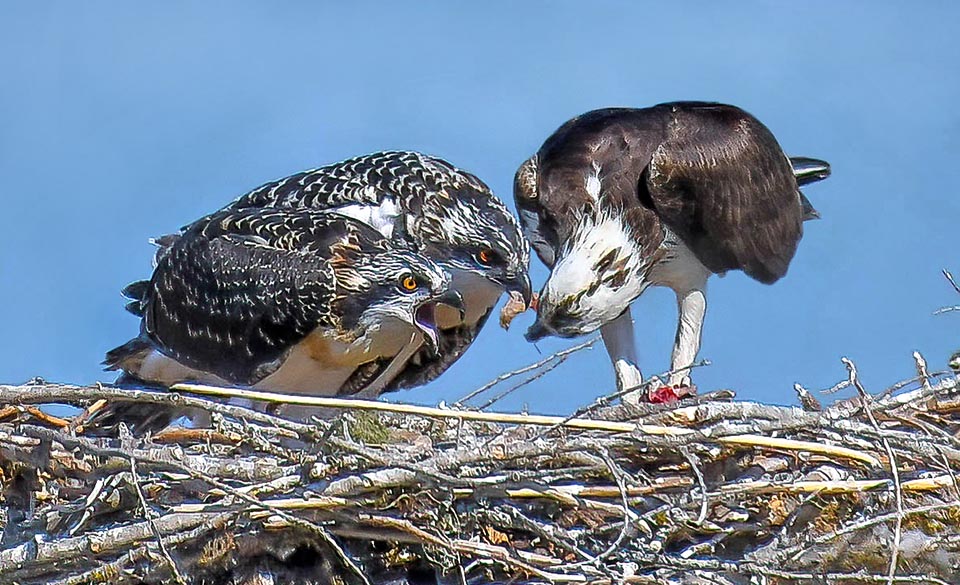
The chicks stay in the nest for 7 or 8 weeks, cared and nourished by both parents, and don’t show the typical cainism present in some eagles © Wesley Barr
The outermost finger is also very mobile and opposable when used during the catching of the preys, becoming, if needed, zygodactylous.
There is not much distinction between adults and young apart from a light paler dotting on the wing cover present in the young.
Ethology-Reproductive Biology
The return of the males from the winter quarters anticipates for some days that of the females in order that by their arrival the first have already retrieved their territory. Though not confirmed, it is thought that the Osprey is a bird faithful to its site of nidification and that it gets back invariably in the same area, confident to be able to place itself again in the same territory.
It nidificates on big trees, well exposed and overlooking their fishing territories or on rocks facing the sea or on lakes even of reduced dimensions, on electricity poles and more and more often on structures specially prepared by man. On some little frequented islands of the Red Sea, the nest is practically on the ground in secluded and poorly frequented sites.
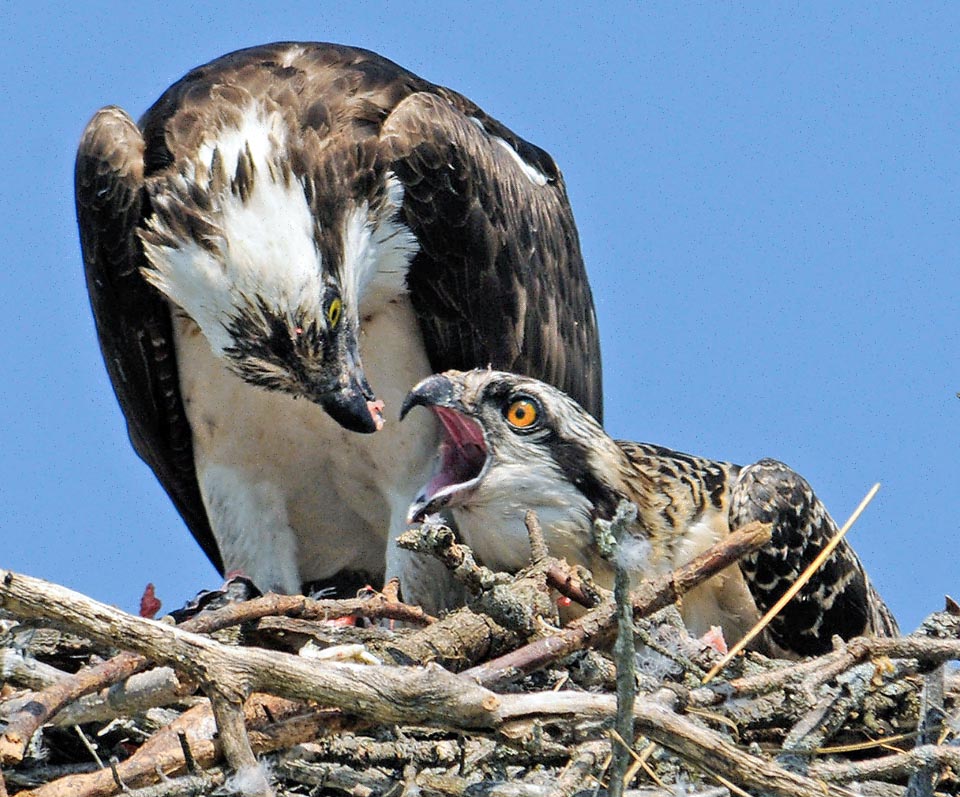
This, now grown, id close to the take off. The kids keep united for some time to the parents, exploiting the same territory and frequenting the same hunting locations © Jean-François Hic
The nest is a platform that reaches gigantic size after some years, so much to often collapse on itself or to make the branches on which it is placed to fall down. The constancy in the use of these nests has exceeded in some ascertained cases, many decades, reaching enormous and unthinkable dimensions, so much so that in the construction of artifacts to entice the return of these birds, they have usually thought to massive structures in iron capable to support abnormal weights over time.
The nest is formed by big branches at the base and covered inside with moss, barks, sedges and twigs increasingly finer, to form an ample and comfortable cup. 2 of 3 and occasionally even 4 are laid, hatched by the female as well as by the male for a period up to 6 weeks, assiduously and seamlessly. It is probable that such a behaviour is due to the fact that the nest is always placed in a very exposed position and hence subject to robbery by corvids, or other habitual sneaky thieves of eggs. In fact, the Common raven and at times big seagulls, result being one of the main causes of the disappearance of entire broods.
The chicks remain in the nest for 7 or 8 weeks, cared for and fed by both parents and do not show the typical siblicide present in some eagles, therefore the average brood is always close to the number of the laid eggs.
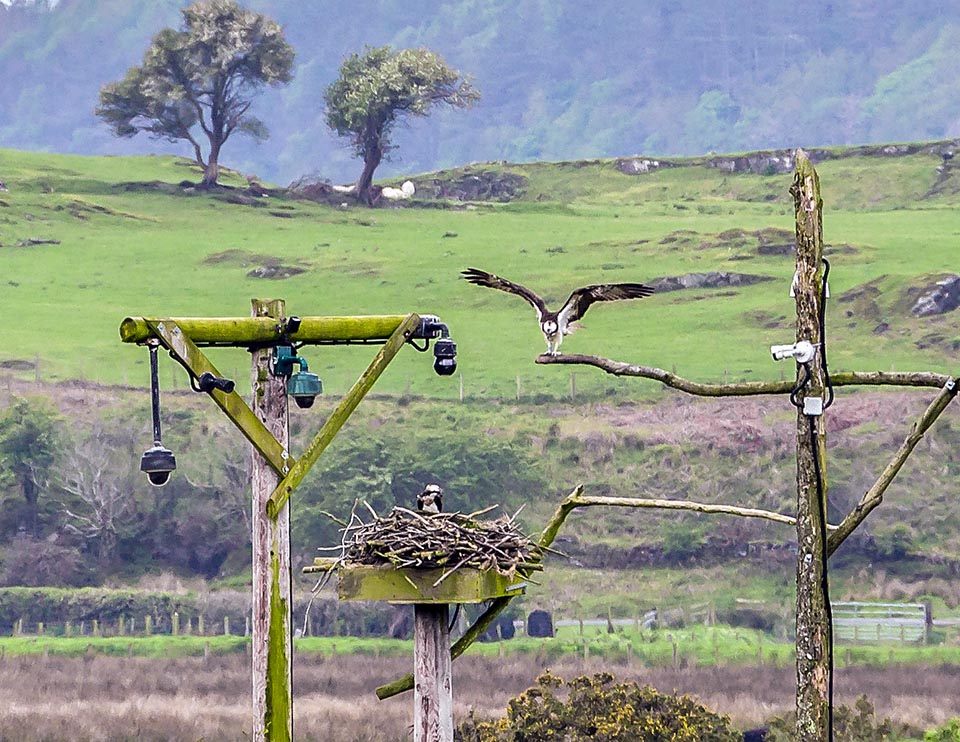
Pandion haliaetus is a hawk particularly loved and respected by all the world. Here, for welcoming and studying them, has been built a platform surveyed by cameras © Alain Piper
At the moment of the take off the chicks remain united for some time to the parents, exploiting the same territory and frequenting the same hunting sites. During this period the young begin a wandering that instinctively leads them south up to the winter quarters but independently from the parents. In these territories the young often remain for the first two years of life coming back to the summer quarters only when they reach maturity. The first nesting occurs usually by the third year of age. The couple is monogamous during the single season and dissolves at the time of the migration.
As previously mentioned, the main food for the Osprey is the fish, with particular attraction for pike, salmon and trout in the cool areas and sea bass, mullet for the Mediterranean marine populations. Rarely the catch involves fishes under the 100/200 g, rightly the quantity of daily meat it needs.
Besides enjoying global protection, this hawk is particularly loved and amply respected all over the world. The species is not endangered and is inserted in the IUCN Red List (2013) as state of conservation least Concern.
Synonyms
Falco haliaetus Linnaeus, 1758.
→ To appreciate the biodiversity within the birds of prey and find other species please click here.
